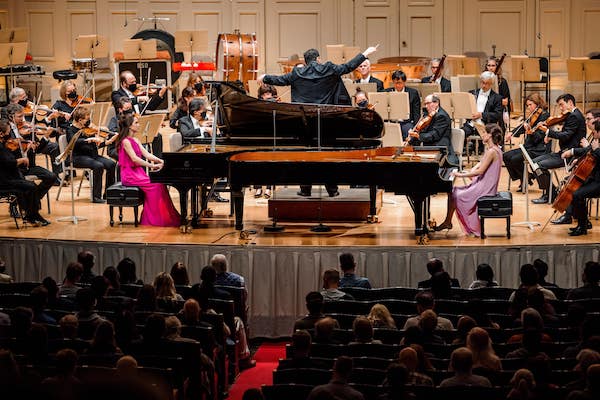Classical Concert Review: Boston Symphony Orchestra plays Strauss and Mozart
By Jonathan Blumhofer
Andris Nelsons’s conception of Strauss’s Tod und Verklärung was impressive, marked by strong contrasts of character, flexibility of phrasing, and a commendable grasp of musical space.

BSO music director Andris Nelsons conducts, with pianists Christina and Michelle Naughton. Photo: Aram Boghosian
To be sure, Richard Strauss and Wolfgang Amadeus Mozart are two very familiar composers to Boston Symphony Orchestra (BSO) audiences. But the pieces by both that the ensemble and music director Andris Nelsons are presenting this weekend are rarities, at least for the BSO.
The night’s most familiar fare, Strauss’s tone poem Tod und Verklärung, last appeared on a Symphony Hall program in 1999. And you’ve got to go back to 1911 to find the orchestra’s prior traversal of the “Love Scene” from Strauss’s 1901 Singgedicht (“sung poem”), Feuersnot.
As for Mozart’s E-flat major Concerto for Two Pianos? That last turned up on a Boston BSO concert the month before Franklin Roosevelt was reelected to his fourth term (October 1944 — though it has, admittedly, been played by the Pops in recent years and at Tanglewood in 1990).
Regardless, Saturday night’s performances of all three — which I caught via the BSO’s first livestream of the season — crackled.
Granted, a video relay can’t fully replicate the vibrant acoustic of Symphony Hall or the thrill of feeling the music when it’s played live. Still, Saturday’s stream was well balanced and sounded both natural and energetic. The direction also moved nimbly between the orchestra’s various sections and, in the Mozart, the soloists.
And what exceptional soloists sisters Christina and Michelle Naughton proved to be in this Double Concerto. There’s something of a familial aspect to the piece to begin with: Mozart wrote it around 1779 to be played, it’s thought, by him and his sister, Nannerl. Whether they ever teamed up on the Concerto is unknown, but it’s not difficult to hear the solo parts’ good-natured exchanges of scales, arpeggios, and subjects — as well as their subtle elaborations (the music’s themes are constantly being varied) — as a sort of spirited jousting between sibling rivals.
That certainly came across on Saturday. In the outer movements, the Naughton duo’s volleying of materials dovetailed with remarkable evenness of spirit and technique. Keyboard textures were lucid. And the sisters’ feel for the music’s shifting shades of colors — particularly its peregrinations into the minor mode during the finale — was compelling.
The slow movement danced gracefully, both between the solo parts and in the keyboards’ exchange of foreground and background roles with the orchestra.
For his part, Nelsons drew a spry accompaniment from the BSO. Keisuke Wakao’s oboe solos were a highlight of the touching slow movement. Afterwards, the Naughtons rewarded a thunderous ovation with an encore of the raucous “Boogie” from Paul Schoenfield’s decidedly un-Mozartian Five Days of a Manic-Depressive.
The concert’s first half belonged to the Strauss selections. Nelsons is a Strauss specialist and this season’s ongoing emphasis on the composer is part of a new recording project he and the BSO are undertaking with Deutsche Grammophon. Perhaps that accounted, partly, for the sheer radiance of the orchestra’s reading of Tod und Verklärung. Written in 1889, the tone poem imagines an old man’s dying hours, his reminiscences of his long life, and, finally, his heroic transition to the next world. While the piece is prefaced by a tendentious poetic plot summary by his friend, Alexander Ritter, Strauss’s music is astonishingly direct and magnificently orchestrated (he was only 25 when he wrote it).
On Saturday, the BSO reveled in the score’s play of colors. The woodwind and string solos all had plenty of room to unfold and breathe but never at the expense of the longer musical line. And the brass playing — particularly the horn writing — blazed. Indeed, Nelsons’s conception of Tod und Verklärung was impressive, marked by strong contrasts of character, flexibility of phrasing, and a commendable grasp of musical space.
Similar qualities were evident in the short “Love Scene,” which opened the concert. A piece that depicts the concluding tryst between Feuersnot’s protagonists, Kunrad and Diemut, the music anticipates the Adagio from Strauss’s Sinfonia domestica of three years later with its slow-burning intensity, complex contrapuntal figures, and yawping brass zeniths.
Neither Strauss’s best nor worst depiction of lovemaking, Saturday’s performance was warm and spacious to begin but grew in fervor and energy as the movement reached its sensuous climax.
The concert repeats at Symphony Hall tonight at 8 p.m. and will be available for on-demand streaming at bso.org/now from October 21 to November 20. bso.org; 888-266-1200
Jonathan Blumhofer is a composer and violist who has been active in the greater Boston area since 2004. His music has received numerous awards and been performed by various ensembles, including the American Composers Orchestra, Kiev Philharmonic, Camerata Chicago, Xanthos Ensemble, and Juventas New Music Group. Since receiving his doctorate from Boston University in 2010, Jon has taught at Clark University, Worcester Polytechnic Institute, and online for the University of Phoenix, in addition to writing music criticism for the Worcester Telegram & Gazette.
Tagged: Andris Nelsons, Boston Symphony Orchestra
